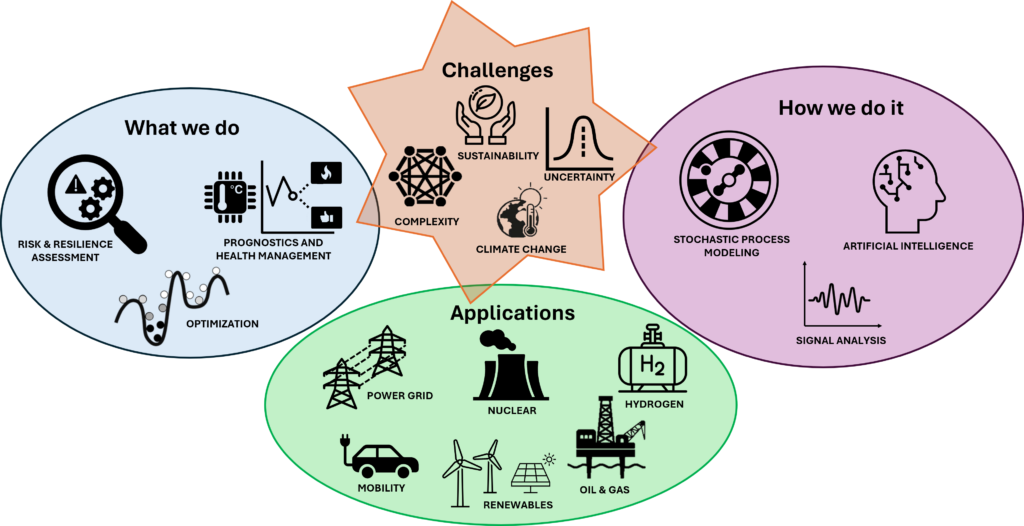LASAR3 mission: safe and sustainable industries and services
The World is in a continuous dynamic transition, wherein the digital, physical and human dimensions are interrelated in socio-cyber-physical systems and where the human centricity is enforced towards a holistic perspective of people-planet-sustainable prosperity (industry 5.0). Globalization, complexity and climate change bring uncertainties and challenges to the safe, sustainable and efficient operation of industrial systems and critical infrastructure.
At LASAR3 we develop computational methods that leverage knowledge, information and data for the safety and sustainability of industries and services.
Across more than 30 years, LASAR3 has been committed to the personal and professional growth of young researchers, breeding more than 20 postdoctoral researchers, 50 PhD students and 100 MSc. Students. The commitment has been pushed through cutting-edge research projects, collaborations with academic and industrial partners, and participation in international conferences.

What we do?
- Risk & Resilience Assessment
In the context of Industry 5.0, Risk & Resilience assessment is pivotal in ensuring that industrial activities are aligned with sustainable development goals, prioritizing human well-being and environmental protection, particularly in the face of the challenges brought by climate change. The broad integration of cyber-physical systems in industry facilitates the real-time monitoring and proactive mitigation of risks, but it also brings additional complexity and challenges that require innovative solutions. At LASAR3 we study and develop state-of-the-art systematic and systemic frameworks of Risk & Resilience assessment for incorporating the relevant knowledge available, with the final objective of informing the related design, operation, maintenance, and management decision-making, pushing beyond the traditional profit-driven vision towards a focus on human-centricity and sustainability. - Prognostics and Health Management (PHM)
Prognostics and Health Management (PHM) integrates knowledge, information and data within model-based and data-driven approaches for the assessment and prediction of Structures, Systems and Components (SSCs) health state, to allow anticipating failures and avoiding accidents. SSCs health state is integrated with future profiles of system operation, spare parts inventory and future production demand in maintenance optimization to improve assets profitability, safety, reliability and sustainability. At LASAR3 we develop methods for industrial applications to face the challenges which impede full deployment of PHM, such as the complexity of modern systems and the uncertainties on present and future knowledge. In this respect, we exploit the availability of data and computer algorithms for further development of PHM and for full deployment of condition-based, predictive and prescriptive maintenance in practice. - Decision making and optimization
Optimization represents a comprehensive field for supporting decision-making, improving the reliability and resilience of systems, enhancing production while effectively managing costs. It involves scheduling system operations and maintenance activities for optimal timing and efficiency, mitigating risks through precise assessment and resource allocation, making informed decisions while dealing with several sources of uncertainty using robust and stochastic models. At its core, optimization techniques seek to find the most efficient and effective solutions by systematically evaluating and refining multiple variables and constraints. At LASAR3 we aim to develop AI-powered robust optimization techniques through leveraging data analytics, machine learning, and condition monitoring to enable dynamic adaptation to complex environments under evolving operational conditions and balance operational reliability with cost minimization, ensuring resilient and efficient operations in the face of different challenges.
How we do it?
- Artificial Intelligence
- eXplainable Artificial Intelligence (XAI)
- Physics Informed Neural Networks (PINN)
- Transfer Learning (TL)
- Natural Language Processing (NLP)
- Grey-Box Models
- Reinforcement Learning (RL)
- Stochastic Process Modeling
- Monte-Carlo Simulations
- Bayesian Networks (BN)
- Markov Models
- Gaussian Processes
- Signal Analysis
- Wavelet Transform
- Fourier Analysis
- Time-Frequency Analysis
- Adaptive Filtering
- Kalman Filtering